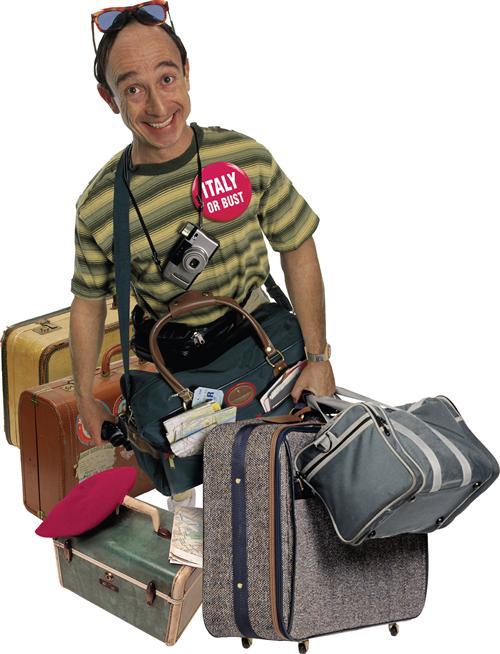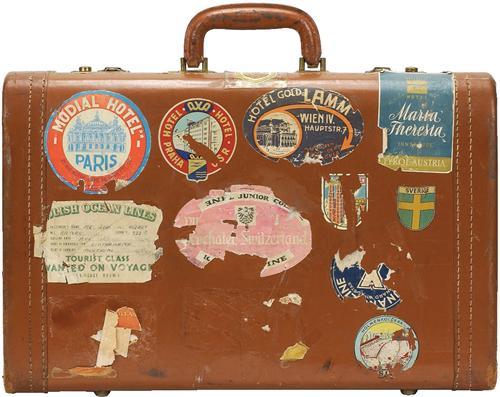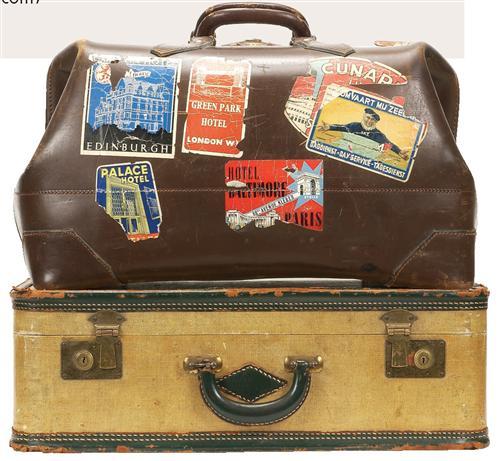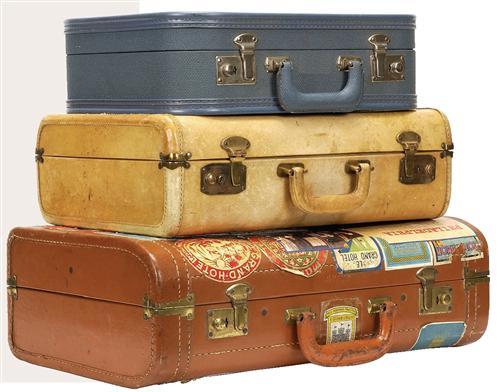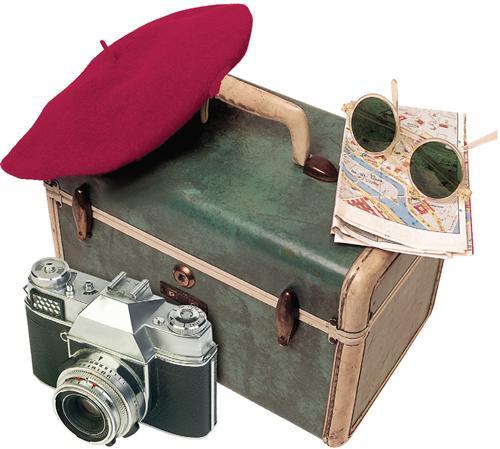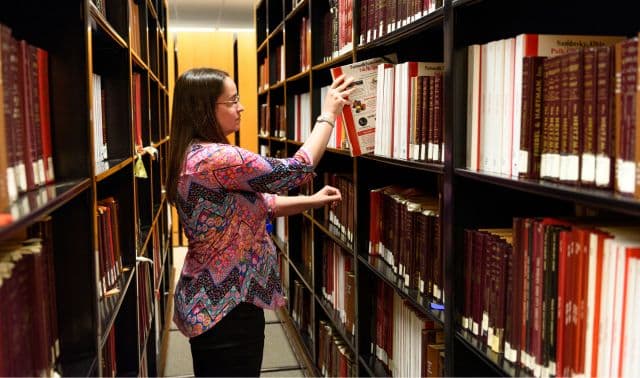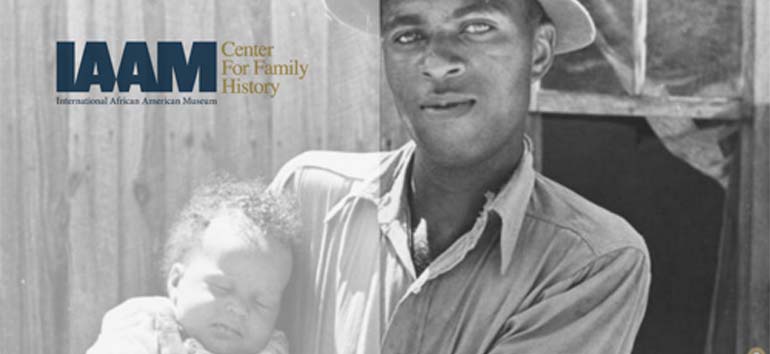You’ve visited the cemeteries where your ancestors are buried, located their homestead in America and scrolled through every roll of microfilm you could get your hands on. But somehow that’s just not enough. A little voice inside you is quietly urging you follow your ancestor’s path overseas — to walk the sod your forebears trod and further your family tree research.
You’re not alone. Genealogists just like you make the pilgrimage to their ancestral homelands every day. There’s something almost spiritual about following in your forebears’ footsteps. And sometimes journeying to records repositories in your ancestral village is the only way to get the answers you’ve been desperately seeking.
Having made six overseas research trips myself, I’ve felt the thrill of connecting with cousins a continent away, the joy of finding my ancestors’ names in centuries-old record books. I’ve also learned the importance of preparation: You don’t want to become one of the American tourists Mark Twain poked fun at in his 1869 book The Innocents Abroad. You know the type — the oblivious traveler with the gigantic camera strapped around his neck, hauling more luggage than an airline baggage handler, waiting for a train to Florence that will never come because he’s at the wrong station.
How can you avoid being one of those tourists? Become a savvy genealogical traveler. You can start with this guide to making the most of your trip.
Great expectations
How would you rather spend your time in the old country — digging up records and immersing yourself in your ancestors’ culture? Or wandering aimlessly through research repositories? You can bypass the latter if you accomplish five things before calling your travel agent:
1. Read foreign-research guides. A critical part of your pre-trip homework is learning where the records you need are located. Some countries have national or regional archives; for others, local municipalities may hold the keys to your past. In Italy, for example, the civil vital records are kept at the town level. In Ireland, if your ancestors were from the province of Ulster, you might be visiting not only the Public Records Office of Northern Ireland <www.proni.gov.uk>, but also repositories in London.
Foreign-research guidebooks tell you what records are available and how to access and use them. You can find applicable titles by combing online library catalogs, booksellers such as Amazon.com <amazon.com> (search on the country name or nationality you’re interested in and genealogy guide), and our very own Ethnic Toolkits <www.familytreemagazine.com/ethnic_intro.asp>. My book entitled A Genealogist’s Guide to Discovering Your Immigrant and Ethnic Ancestors (Betterway Books, out of print) also provides lists of research guides.
Additionally, the Church of Jesus Christ of Latter-day Saints’ Family History Library (FHL) <www.familysearch.org> publishes research outlines for 20 countries, mostly in Western Europe, Scandinavia, and Central and South America. (From the FamilySearch home page, click on Guides, then Research Outline.) These outlines provide overviews of the records available through the FHL and some other research repositories.
As you’re learning about the records you can access, start making a list of specific research goals. Prioritize your list, as you may not get through it all on your first trip. Decide which families are most important to your current research, and focus on them. Then if you have extra time, you can look for more.
Though many guidebooks include maps, you’ll probably want to purchase a separate map or atlas so you can understand the geographic jurisdictions of your ancestral homeland. For European road maps, try ViaMichelin <viamichelin.com> or look for printed atlases and maps at bookstores.
2. Join an ethnic genealogy group. Networking with other genealogists who’ve traveled to your ancestral homeland can help you as you plan your trip. Though you may not share a common ancestor, foreign-research veterans can offer you valuable guidance from their firsthand experiences and warn you of common pitfalls and mistakes. You can meet such genealogists by joining a genealogical society focused on a country or ethnic group.
Just about every ethnic group has a genealogical society; to find one for your heritage, type the name of the ethnic group or country, followed by genealogical society, into a Web search engine. (Also try genealogical societies, as you may get different results.) In addition to country-specific groups, you’ll find regional organizations such as the Federation of East European Family History Societies <feefhs.org>, which (as the name suggests) covers most countries in Eastern Europe, and the International Society for British Genealogy and Family History <www.isbgfh.org>, which caters to anyone researching Anglo-Irish, Welsh and Scottish ancestors, as well as people who settled in parts of the British Commonwealth. Look for groups on Cyndi’s List <cyndislist.com/soc-gen.htm#ethnic>, too. (Keep in mind, however, that some foreign genealogical groups are geared toward royal and noble ancestry, not common-folk roots.)
Ethnic genealogical societies usually have members from all over the United States and sometimes from the ancestral country. Some may sponsor seminars on ethnic and foreign research, or group genealogical research trips. Their newsletters, journals and Web sites may offer advice, too.
3. Exhaust foreign sources in America. This will save you countless hours and dollars when you travel. The FHL has microfilmed records from all over the world — not every record for every country has been microfilmed, of course, but you’d be surprised at what’s available. Go to the FHL catalog (click the link on the FamilySearch home page) and do a keyword search for the country and town names. If nothing comes up, try typing in the country, followed by the next-largest geographic jurisdiction, such as a province, county or region. If the records for your ancestral village haven’t been filmed, look at records from neighboring villages to see what types of documents you might find and how they’re formatted.
Don’t forget: Many records won’t be written in English. Even in English-speaking countries, you could find yourself trying to translate Latin church records. To overcome this obstacle, the FHL once again comes to the rescue. You can find word lists with genealogical terms such as dates, numbers, months, relationships, events and so forth at FamilySearch (click Guides, then Word List). You also should purchase a translation dictionary. Many foreign research guidebooks have word lists, too, and some may translate standard form documents, such as birth, marriage and death records.
4. Write for records. This step is especially important if none of the records you want have been microfilmed: You’ll get an idea of the kinds of records you’ll be looking at abroad — and how helpful the custodian of those records will likely be when you get there. Foreign guidebooks should tell you what sources you can obtain through correspondence and where to write for those records. Some of that information also may be available at the foreign-record repository’s Web site. Look for form-letter translations in guidebooks, too, or check out the FHL’s online letter-writing guides (under the Guides link) for Czech and Slovak, Finnish, French, German, Italian, Polish, Portuguese and Spanish.
When you write for foreign records, include two International Reply Coupons with each request instead of a self-addressed, stamped envelope. Foreign post offices don’t accept US stamps, and their envelope sizes may differ from ours. Don’t send foreign currency to cover any required fees — instead, get an international money order, available at some post offices and banks. Use the Universal Currency Converter <xe.net/ucc> to get the current exchange rate and convert the amount you’ll send. You can find out how much money you’ll need to send by consulting current editions of foreign-research guide-books and talking with others who have requested records by mail.
5. Send letters to relatives. If you’ve uncovered letters to your relatives written by someone in the old country, try writing to whomever now lives at the return address. (Just address the envelope to Current Resident.) In your letter — which should be in the native language — say you’re searching for relatives of a previous occupant. Ask the current resident if he knows of the family or a neighbor, and where you might get in touch with relatives. You also could post similar queries online; just remember that not everyone has a computer or Internet access.
Try sending letters to everyone with your surname in the ancestral village, too. You’ll find international phone numbers and addresses online at Infobel.com <infobel.com>, or type international telephone directories into a search engine. Remember to include two International Reply Coupons.
Flight plans
Whew! Now that you’ve done your homework and researched the availability of the records you seek, it’s time to decide whether you’ll make the trip to your ancestral country on your own or with a group.
For those who’ve never been abroad or done any genealogical research in a foreign country, a group trip is ideal. Make sure, however, that you choose a trip to research in repositories if that’s what you’re interested in. Many group excursions to European countries are “heritage tours” — which take you to historic sites, not research venues.
On genealogical group trips, your group leader and returning researchers will be happy to help you get acclimated to your surroundings and point you in the right research direction. You’ll likely have to pay for your airfare separately and get the meeting point on your own, but the rest of the trip will be planned for you. The trip price normally includes lodging (usually shared), some meals and ground transportation once you meet up with the group.
Most group trips last a week to 10 days; a few last as long as three weeks. And some genealogical tour companies limit their group sizes so you can get individual attention and take full advantage of your time. Since the group itinerary may not give you much opportunity for exploring, sightseeing or tracking down your ancestor’s home site, plan to arrive early or stay after if you want to do those activities.
Prefer to go alone or with a friend or family member? You’ll certainly have more freedom to do what you want. Your entire itinerary will be specific to your needs, and you can change it along the way if you discover something that takes you to another part of the country. Of course, you’ll need to make all your travel arrangements — air travel, accommodations, and car rental or train and bus tickets — on your own or through a travel agent. You’ll also have to find out the hours of the repositories you plan to visit and make sure they’ll be open on the days you want to stop by (look online, in genealogical guides and in travel books). When you get to the repository, check in with the reference desk and let the staff know this is your first time there, just as you would on your first visit to a US repository. Most staff will gladly give you an orientation.
To make your solo trip more productive, you might want to hire a local guide or genealogist to help you navigate foreign cities and repositories, says Celtic Journeys owner Judy Lowstuter. (Her company organizes individual research trips to Scotland and Ireland — see box, opposite page.) The guide can tell you about places and resources that might not be in your guidebooks. Although it’ll add extra expense to your trip (in major cities, a researcher may charge $50 an hour; it’s generally less in rural areas), you may find the time saved and knowledge gained worth it. See the next page for tips on finding and hiring a foreign researcher.
Alternatively, it wouldn’t hurt to have a translator to help you overcome the language barrier. If you’re familiar enough with the records from looking at them on microfilm, you might be able to get by without one — assuming you know how to request the records. Ask your travel agent to recommend someone in the area, or contact a nearby foreign language school in the area you’ll be traveling to. (Group travelers likely won’t need this — your leader or other staff will probably serve as your translator.)
Smooth landing
You’ve finally arrived! Whether you’ve come with a group or by yourself, use day one to get acclimated to the new time zone and surroundings. Take it easy: Go sightseeing, window shop or visit a cemetery. The next morning, you can hit the ground running and start digging through ancestral records.
Try to arrive at research repositories right after they open, when they’ll likely be less crowded and the staff will have time to give you an orientation. Show your list of research goals to a staff member so he or she can help you get started quickly. If you’re with a group, your leader should give you an orientation.
Remember, every country and municipality has different record-keeping practices and access policies. In repositories set up for research, you’ll usually find the staff helpful. But in small towns and villages where you’re dealing with record clerks and clergy, the story might be different. I lucked out in tiny Terlizzi, Italy, where the clerk left me on my own to go through the records. In the larger city of Potenza, a short drive away, the clerk wouldn’t let me anywhere near the record books. Have your research goals and a list of names and dates handy, so you or the clerk can look up information easily.
And keep in mind that not all archives are operated by a government. Some countries, such as Sweden, also have privately run archives that may charge fees to use their facilities, says Trilby Gustafson, owner of Denmark-based genealogical tour company Scandgen. Of course, you should also be prepared to pay for photocopying and other on-site research services, just as you would if you were doing research in state-side repositories.
Though genealogy may be your primary goal, don’t spend your entire trip holed up in archives. Get out and explore your ancestral homeland. Witness the customs and lifestyles. Visit museums — especially living history sites — to get a feel for what life was like in your ancestors’ day. Depending on existing documents and your research, you might even be able to pinpoint your ancestor’s home site, and with luck, the house might still be standing.
Cousin connections
On every trip I’ve made to Ireland and Italy looking for distant cousins, it seems as if they’re all just waiting for a relative from America to come and find them. If your letter-writing campaign was successful, you may have identified cousins to visit before you left. Otherwise, ask at the record-keeper’s office. She may know everyone in town. Also ask at the church your ancestors attended and in restaurants, pubs, cafés, the town library — anywhere you can think of. Trust me, word will get around.
On my first day in Terlizzi, I dropped off a copy of my Vallarelli family history at the town library. The next day, as I was touring the local museum, a woman rushed in saying, “Where is the American woman? I think I’m related to her.” A friend of hers had been at the library when I dropped off my book. She overheard my conversation with the librarian and called her friend to tell her about me. The town was so small that all the residents knew an American was visiting and tracked my every move, so the woman knew right where to find me. And indeed, she was right. We’re related.
Most people who go overseas in search of relatives receive an amazingly welcoming reception: You’ll find cousins who’ll invite you into their homes for meals, and take you on tours to the local cemetery and home sites. They’re happy to share the local history and customs with you if ask.
After your trip, always send thank-you notes and maybe even small gifts to people who helped you. Didn’t leave a donation at the church whose records you used? Send one now. If you ever need to write for records, you always can remind the clerk of your visit and gift (this may get you a better and faster response through the mail). The clerk is more likely to remember you when you make a second visit, too.
Toolkit
Web Sites
? Cyndi’s List: Travel and Research
? Czech and Slovak Heritage: Good Travel Advice
<www.czechheritage.net/cztravel.html>
? Eurapart
? European Travel Basics 101
<budgettravel.about.com/bl_eurobasic.html>
? Fodor’s
? Frommer’s
? Genealogical Vacation
<www.budgettravelonline.com>: Under Spotlights, click on Specilty Travel and then Genealogy Vacations.
? Hostels.com
? Rick Steves’ Europe
? Transitions Abroad: Budget Travel
<www.transitionsabroad.com/listings/travel/budget>
? US Department of State: Passports
? A Genealogist’s Guide to Discovering Your Immigrant and Ethnic Ancestors by Sharon DeBartolo Carmack (Betterway Books, out of print)
? Handbooks for Foreign Genealogical Research: A Guide to Published Sources in English by Virginia S. Wood (Library of congress, out of print)
? Jewish Heritage Travel: A Guide to East-Central Europe by Ruth Ellen Gruber (Jason Aronson, out of print)
? Lonely Planet Europe on a Shoestring by Sarah Johnstone, China Williams and Reuben Acciano (Lonely Planet Publications)
? Rick Steves’ Europe Through the Back Door 2006 by Rick Steves (Avalon Travel Publishing)
? Searching on Location: Planning a Research Trip by Anne Ross Balhuizen (Ancestry)
Leaders of the Pack
Interested in a group trip? Try these tour companies:
? Ancestor Travel
Travel Match Ltd., The Lodge, Sheen Court Road, Richmond upon Thames, Surrey, England, TW10 5DF, <www.ancestortravel.com>: Great Britain and Ireland
? Ancestral Roots Travel
St. Leonard’s House, Upper Linney, Ludlow, Shropshire, England, SY8 1EF, +44 (15) 84-873554, <www.ancestralrootstravel.com>: Ireland, Scotland, England, Poland, Ukraine and Russia
? Ashton Drye
95 Squire Place, Orchard Park, NY 14127, (716) 667-3359, <ashtondrye.com>: British Isles
? Celtic Journeys
7109 Village Drive, Annandale, VA 22003, (703) 941-6455, <www.celticjourneys.us>: Scotland and Ireland
Celtic Quest
Box 6386, Plymouth, MI 48170, (734) 354-6449, <www.celticquest.net>: Ireland
? Elderhostel
11 Ave. de Lafayette, Boston, MA 02111, (877) 426-8056, <www.elderhostel.org>: Various countries
? Enchanting Ireland
5410 Woodbine Ave., Philadelphia, PA 19131, (800) 659-3800, <WWW.enchantingireland.com>: Ireland
? European Focus
508 Pineapple Ave., Sarasota, FL 34236, (941) 330-0877, <www.eurofocus.com>: Germany, Austria, Switzerland, Belgium, Holland and Alsace, France, plus assistance with tours to Italy, Scandinavia and Great Britain
? Genealogy Research and Heritage Travel in Norway
Norwegian Adventures AS, Box 46, N-3834 Gvarv, Norway, (800) 413-0156, <www.norwegianadventures.com/heritage.htm>: Norway
? Genline Family Travel
Rökerigatan 5, SE-12162, Johanneshov, Sweden, (847) 229-7032, <www.genlinefamilytravel.com>: Sweden
? Homemade Holidays
31 Glastonbury Drive, Middlewich, Cheshire, England, CW10 9HR, (800) 813-7352, <www.homemade-holidays.com>: Great Britain, Scotland and Wales
? Institute of Genealogy & Historical Research
Samford University Library, Birmingham, AL 35229, (205) 726-2198, <www.samford.edu/schools/ighr/bighr.html>: London; Dublin and Belfast
? The Irish Ancestral Research Association
Dept. T, 2120 Commonwealth Ave., Auburndale, MA 02466 (617) 367-4968, <home.netcom.com/~megrogan>: Dublin and Belfast
? Italian Heritage Tours
Box 174 Reynoldsburg, OH 43068, (800) 829-2201, <www.italianheritagetours.com>: Italy
? Nonstop Travel
833 W. Torrance Blvd., Torrance, CA 90502, (800) 949-6362, <www.germanroots.org>: Germany
? Routes to Roots
136 Sandpiper Key, Secaucus, NJ 07094, (201) 601-9199, <routestoroots.com>: Ukraine, Moldova and Belarus
? Scandgen
Scandgen Specialty Tours, Kvaedegangen 9, DK-3460 Birkerod, Denmark, +45 (40) 76-3887, <www.scandgen.com>: Scandinavia

